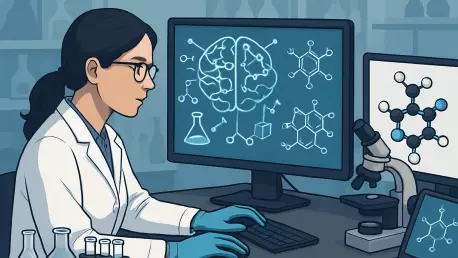Imagine a realm where artificial intelligence transcends mere data crunching to become a dynamic partner in crafting life-altering medications, pioneering advanced materials, and unraveling intricate chemical mysteries with unprecedented speed. This vision is no longer a distant dream but a tangible reality, thanks to the emergence of Multimodal Language Models (MMLMs). These cutting-edge AI systems are revolutionizing the fields of chemistry and materials science by seamlessly integrating diverse data forms—text from scientific journals, visual imagery, numerical results, and chemical structures. The impact is profound, shattering the constraints of conventional research methods and ushering in an era of unprecedented speed and innovation. MMLMs are not just tools; they are catalysts that enable scientists to achieve breakthroughs that once seemed out of reach.
This transformation goes beyond accelerating timelines; it redefines the very approach to scientific inquiry. By offering a comprehensive perspective on complex systems, MMLMs surpass the limitations of earlier, single-focus AI technologies. Their ability to connect disparate data sources sparks insights that might have taken years to surface through traditional means. As these models become integral to laboratories worldwide, they promise to reshape how discoveries are made and applied. The journey into this new frontier raises compelling questions about the mechanisms behind their success, their implications for industries, and the future they are poised to create. Exploring these dimensions reveals the true scope of this technological marvel.
Unlocking Insights Through Data Fusion
The core strength of MMLMs lies in their capacity to process and synthesize multiple data types at once. These models adeptly handle scientific literature, analyze detailed microscopy visuals, interpret experimental datasets, and decode specialized chemical notations like SMILES strings or 3D atomic configurations. This multifaceted approach marks a significant departure from older AI systems that were confined to a single data mode. By breaking down barriers between isolated data sets, MMLMs provide researchers with a richer, more interconnected understanding of chemical and material behaviors. This holistic view enables the identification of trends and relationships that might otherwise remain hidden, fostering a deeper level of analysis.
Such integration fundamentally enhances the research process. From formulating initial hypotheses to predicting the characteristics of novel materials, MMLMs streamline workflows by bridging gaps across data sources. This capability has led to remarkable advancements, such as the development of improved battery components and innovative solutions for CO2 capture. The efficiency gained through this approach not only saves valuable time but also opens doors to solutions that traditional methods might have overlooked. As a result, scientists can tackle challenges with a level of precision and insight that redefines the boundaries of possibility, setting a new standard for discovery in these fields.
Streamlining Research with Automation
Another transformative aspect of MMLMs is their ability to automate labor-intensive aspects of scientific work. Tasks that once consumed countless hours—such as combing through extensive research papers, aggregating disparate data sets, or interpreting manually drawn chemical structures—are now managed swiftly by these advanced systems. This automation transcends mere time-saving; it liberates researchers to concentrate on strategic thinking and experimental creativity. A notable example is the work done by IBM Research, where MMLMs have been employed to forecast properties of complex systems like battery electrolytes, drastically reducing the manual workload involved in such intricate predictions.
The implications of this automation extend to reshaping laboratory dynamics. By offloading repetitive and mundane tasks, MMLMs enable research teams to channel their expertise into innovation and problem-solving. This shift fosters an environment where human intellect is paired with technological efficiency, accelerating the pace of scientific progress. Laboratories can now operate with heightened agility, focusing on groundbreaking experiments rather than being bogged down by routine processes. This evolution in workflow management signals a departure from traditional research constraints, paving the way for a more dynamic and responsive approach to scientific challenges.
AI as an Active Research Partner
A striking development in the application of MMLMs is the advent of agentic AI frameworks, such as ChemCrow and LLMatDesign. These systems go beyond passive data processing to actively engage in research tasks, designing molecular structures and simulating material properties with minimal human intervention. This represents a paradigm shift, positioning AI not merely as a supportive tool but as a collaborative partner in the laboratory. The concept of “self-driving laboratories” is gaining traction, where AI autonomously plans and conducts experiments, achieving results with remarkable accuracy and efficiency.
This move toward autonomy holds transformative potential for the scientific community. By diminishing the reliance on extensive physical testing, agentic AI conserves resources while hastening the discovery process. The vision of fully AI-driven labs, capable of conceptualizing and testing new compounds independently, is no longer a distant prospect but an emerging reality. Such advancements could dramatically shorten research timelines, enabling rapid responses to pressing global needs, from sustainable energy solutions to novel pharmaceuticals. The integration of AI as a proactive teammate challenges conventional notions of research roles, heralding a future where technology and human ingenuity are seamlessly intertwined.
Reshaping Industry and Expanding Access
The influence of MMLMs extends well into the corporate sphere, creating significant ripples across various sectors. Major technology firms like IBM, Google, and Microsoft are in a competitive race to incorporate these multimodal capabilities into their cloud-based platforms, delivering robust tools for scientific exploration. Simultaneously, specialized startups are emerging, targeting specific applications such as drug discovery, and intensifying the drive toward comprehensive AI solutions. This competitive landscape promises to deliver faster and more cost-effective results, impacting industries from energy storage to healthcare with innovative breakthroughs.
Equally impactful is the potential for MMLMs to democratize access to advanced research tools. Smaller laboratories and independent researchers, often limited by funding and resources, stand to gain from these technologies, which were once the domain of well-resourced giants. This broadening of access could ignite innovation from diverse and unexpected sources, enriching the scientific community with fresh perspectives. The possibility of a more inclusive research environment, where cutting-edge tools are available to all, enhances the collective capacity to address complex global challenges. This democratization signals a shift toward equity in scientific advancement, fostering a collaborative spirit across the field.
Envisioning Tomorrow’s Scientific Landscape
Reflecting on the strides made by MMLMs, it’s evident that their integration into chemistry and materials science marked a turning point in how research is conducted. These models redefined efficiency by merging diverse data streams, automating tedious tasks, and acting as autonomous partners in discovery. Their influence reshaped not only academic pursuits but also industrial applications, driving innovations that addressed critical needs in energy, medicine, and beyond. The journey of adopting MMLMs highlighted both their immense potential and the necessity for careful oversight to ensure reliability and ethical use.
Looking ahead, the focus must shift to refining these technologies for even greater impact. Addressing challenges like model interpretability, data security, and standardized evaluation metrics will be crucial for sustained trust and progress. Encouraging collaboration between tech developers, researchers, and policymakers can help navigate ethical considerations, ensuring that advancements benefit society broadly. As the capabilities of MMLMs continue to evolve, the scientific community stands on the brink of a new era, where AI-driven insights could unlock solutions to some of humanity’s most pressing problems. This path forward demands a balance of innovation and responsibility, setting the stage for a future rich with possibility.









